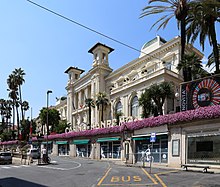Sanremo Casino
This article may rely excessively on sources too closely associated with the subject, potentially preventing the article from being verifiable and neutral. (February 2015) |

Sanremo Casino, officially named Casinò Municipale di Sanremo is a gambling and entertainment complex located in Sanremo, on the Italian Riviera. Many movies were shot in the casino, including Lucky Night (1941), At the Bar Sport (1983), Infelici e contenti (1992), and Fortunata (2017).[1]
History[]
The Casino's building was designed by French architect Eugène Ferret, opening 12 January 1905.
Seven different projects were submitted, resulting in the victory of Ferret, who adhered to the Art Nouveau movement, so much in vogue in France back then. Ferret was also to be the first manager of the proper gaming activities by an agreement signed on 5 November 1903.
From 1913 the Casino had its own tram connection.
In 1927, by means of normalizing a situation of tolerance that lasted for years and in order, among other things, to cope with competition from neighbouring Côte d'Azur; the RDL n. 2448 from 22 December 1927 "Ruling in favour of the City of Sanremo" was converted into Law n. 3125 of 27 December 1928; allowing the City of Sanremo, quite exceptionally, to engage in gambling activities and also allowing an arrangement of the municipal budget so to facilitate the execution of major public works.
The Casino was first born as a Kursaal, and initially its building held theatre programmes, concerts and eateries as well as serving as a meeting place for foreigners. From 1927 to 1934 the Casino was managed by Luigi De Santis who proved to be, among other things, a first-rate gamester for its knowledge of the game and the particularities of the world around it.
In the 1930s, Pietro Mascagni, Luigi Pirandello and were regular clients of the Casino, along with other prestigious artists like Francesco Cilea, Sem Benelli, Umberto Giordano, Franco Alfano, Francesco Malipiero the town. De Santis invited Marta Abba to Sanremo and offered her the Compagnia Stabile (Theatre Company) of which Pirandello was to be its Artistic Director. It also granted funds to Pastonchi for the organisation and setting up of the Literary Mondays.
On April 14, 1934 the company changed its name to Società Anonima Iniziative Turistiche (SAIT). In October of the same year, due to the death of Cavalier De Santis, the shares passed to his wife Maria Strambini who in the early months of 1935 sold them to Cavalier Angelo Belloni who took over the management.
The Casinò di Sanremo closed its doors on 10 June 1940. Still, undamaged by the war and two German and allied occupations; the Casino resumed its activities seven months after the end of World War Il. The Casinò di Sanremo has been, for many years (until 1976) home of the Festival della canzone italiana.
After the war[]
After the years of conflict, the casino officially reopened on the evening of December 31, 1945. In the spring of 1948 the concessionaire company CIRT (Italian Tourism Reconstruction Company) was ousted, so the Ministry of the Interior on February 25, 1948 commissioned the casino with the prefect Omodeo Salè, who managed to fix the situation that had previously got out of hand. Alongside the normal management of the casino, many worldly evenings that attracted the customers of the first post-war period back to Sanremo. At the end of 1949 the tender saw Commendator Pier Busseti as the new dealer of the gambling house.
On January 29, 1951, the first edition of the Sanremo Festival presented by Nunzio Filogamo took place in the party hall. The casino was the seat of the Italian Song Festival continuously from 1951 to 1976; in 1977 he moved to the Ariston Theater.
On February 19, 1953, following the death of Commendatore Pier Busseti, the concession of the casino was entrusted to the ATA company of the Milanese industrialist, as well as Inter president, . In January 1959, the ATA leadership was taken by the lawyer Luigi Bertolini, owner of the Reale hotel. During the Bertolini management, a bribe scandal broke out which overwhelmed the municipal administration, including the mayor Viale. On February 16, 1969 the casino was commissioned, the management alternated with the direct organisation of the municipality, which took place in the eighties. On 1 December 2001 the company Casinò Spa was established, whose sole shareholder is currently the Municipality of Sanremo. Casinò Spa has relaunched the Sanremo gambling house, an entertainment center, home to international events and high-level cultural events. The catering offer managed by the international company Elior is renowned.
References[]
- ^ "Cinema e Casinò: i film più belli girati a Sanremo" (in Italian). 20 April 2020.
External links[]
![]() Media related to Casino (Sanremo) at Wikimedia Commons
Media related to Casino (Sanremo) at Wikimedia Commons
Coordinates: 43°44′22″N 7°25′44″E / 43.73944°N 7.42889°E
- Casinos in Italy
- Art Nouveau architecture in Italy
- 1905 establishments in Italy
- Casino stubs
